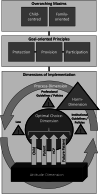Combining the best interest standard with shared decision-making in paediatrics-introducing the shared optimum approach based on a qualitative study
- PMID: 32809079
- PMCID: PMC7886834
- DOI: 10.1007/s00431-020-03756-8
Combining the best interest standard with shared decision-making in paediatrics-introducing the shared optimum approach based on a qualitative study
Abstract
Paediatric decision-making is the art of respecting the interests of child and family with due regard for evidence, values and beliefs, reconciled using two important but potentially conflicting concepts: best interest standard (BIS) and shared decision-making (SD-M). We combine qualitative research, our own data and the normative framework of the United Nations Convention on the Rights of Children (UNCRC) to revisit current theoretical debate on the interrelationship of BIS and SD-M. Three cohorts of child, parent and health care professional interviewees (Ntotal = 47) from Switzerland and the United States considered SD-M an essential part of the BIS. Their responses combined with the UNCRC text to generate a coherent framework which we term the shared optimum approach (SOA) combining BIS and SD-M. The SOA separates different tasks (limiting harm, showing respect, defining choices and implementing plans) into distinct dimensions and steps, based on the principles of participation, provision and protection. The results of our empirical study call into question reductive approaches to the BIS, as well as other stand-alone decision-making concepts such as the harm principle or zone of parental discretion.Conclusion: Our empirical study shows that the BIS includes a well-founded harm threshold combined with contextual information based on SD-M. We propose reconciling BIS and SD-M within the SOA as we believe this will improve paediatric decision-making. What is Known: • Parents have wide discretion in deciding for their child in everyday life, while far-reaching treatment decisions should align with the child's best interest. • Shared decision-making harbours potential conflict between parental authority and a child's best interest. What is New: • The best interest standard should not be used narrowly as a way of saying "Yes" or "No" to a specific action, but rather in a coherent framework and process which we term the shared optimum approach. • By supporting this child-centred and family-oriented process, shared decision-making becomes crucial in implementing the best interest standard.
Keywords: Best interest standard; Paediatric ethics; Parental authority; Qualitative research; Shared decision-making.
Conflict of interest statement
The authors declare that they have no conflict of interest.
Figures
References
MeSH terms
Grants and funding
LinkOut - more resources
Full Text Sources
Medical
Miscellaneous



